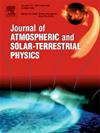Evaluation of water vapor from CARRA reanalysis based on GNSS and radiosonde observation in the Arctic
IF 1.8
4区 地球科学
Q3 GEOCHEMISTRY & GEOPHYSICS
Journal of Atmospheric and Solar-Terrestrial Physics
Pub Date : 2025-01-11
DOI:10.1016/j.jastp.2025.106431
引用次数: 0
Abstract
The Arctic has a significant impact on global climate change because of its special geographical location. Meanwhile, water vapor is one of the most important atmospheric components influencing climate change. In this study, the accuracy of precipitable water vapor (PWV) from Copernicus Arctic Regional Reanalysis (CARRA) is evaluated with 45 Global Navigation Satellite System (GNSS), 13 radiosonde stations and ERA5 reanalysis during 2020–2022 in the Arctic. The mean bias values of CARRA PWV using GNSS PWV, radiosonde PWV and ERA5 PWV are 0.30 mm, −0.00 mm and 0.21 mm, respectively. The results show that the CARRA PWV is mostly overestimated compared with GNSS and ERA5 PWV and not much different for the radiosonde PWV. The RMSE values of CARRA PWV using GNSS PWV, radiosonde PWV and ERA5 PWV are 0.71 mm, 0.40 mm and 0.67 mm, respectively. The results indicate that CARRA PWV has good agreement with GNSS PWV, radiosonde PWV and ERA5 PWV, but CARRA PWV is better agreement with radiosonde PWV. Afterwards, the seasonal bias and RMSE values of CARRA PWV using GNSS PWV, radiosonde PWV and ERA5 PWV are analyzed. The RMSE in the warm season is obviously higher than that in the cold season. Finally, the monthly RMSE values of CARRA PWV are analyzed. The results show that the RMSE values of CARRA PWV with respect to GNSS PWV, radiosonde PWV and ERA5 PWV are large in the warm season and small in the cold season, thereby indicating that the accuracy of CARRA PWV has obvious seasonality. The RMSE values of CARRA PWV and radiosonde PWV are smaller than the RMSE values of CARRA and GNSS PWV and CARRA PWV and ERA5 PWV in every month. The results illustrate that CARRA PWV has better consistency with radiosonde PWV compared with GNSS and ERA5 PWV even in every month.
基于GNSS和探空观测的北极地区CARRA再分析水汽评价
由于其特殊的地理位置,北极对全球气候变化有着重大的影响。同时,水蒸气是影响气候变化最重要的大气成分之一。利用45个全球导航卫星系统(GNSS)、13个无线电探空站和ERA5再分析,对哥白尼北极区域再分析(CARRA)的可降水量(PWV)精度进行了评估。使用GNSS PWV、探空PWV和ERA5 PWV的CARRA PWV的平均偏置值分别为0.30 mm、- 0.00 mm和0.21 mm。结果表明,与GNSS和ERA5的PWV相比,CARRA的PWV大多被高估,而与探空仪的PWV差异不大。GNSS PWV、探空PWV和ERA5 PWV对CARRA PWV的RMSE值分别为0.71 mm、0.40 mm和0.67 mm。结果表明,CARRA PWV与GNSS PWV、探空PWV和ERA5 PWV具有较好的一致性,但CARRA PWV与探空PWV的一致性较好。然后分析了GNSS PWV、探空PWV和ERA5 PWV对CARRA PWV的季节偏差和RMSE值。暖季RMSE明显高于冷季RMSE。最后,分析了CARRA PWV的月均方根误差值。结果表明:CARRA PWV相对于GNSS PWV、探空PWV和ERA5 PWV的RMSE值在暖季较大,在冷季较小,表明CARRA PWV精度具有明显的季节性;各月CARRA PWV和探空PWV的RMSE值均小于CARRA和GNSS PWV、CARRA PWV和ERA5 PWV的RMSE值。结果表明,即使在每个月,CARRA PWV与探空PWV的一致性也优于GNSS和ERA5 PWV。
本文章由计算机程序翻译,如有差异,请以英文原文为准。
求助全文
约1分钟内获得全文
求助全文
来源期刊

Journal of Atmospheric and Solar-Terrestrial Physics
地学-地球化学与地球物理
CiteScore
4.10
自引率
5.30%
发文量
95
审稿时长
6 months
期刊介绍:
The Journal of Atmospheric and Solar-Terrestrial Physics (JASTP) is an international journal concerned with the inter-disciplinary science of the Earth''s atmospheric and space environment, especially the highly varied and highly variable physical phenomena that occur in this natural laboratory and the processes that couple them.
The journal covers the physical processes operating in the troposphere, stratosphere, mesosphere, thermosphere, ionosphere, magnetosphere, the Sun, interplanetary medium, and heliosphere. Phenomena occurring in other "spheres", solar influences on climate, and supporting laboratory measurements are also considered. The journal deals especially with the coupling between the different regions.
Solar flares, coronal mass ejections, and other energetic events on the Sun create interesting and important perturbations in the near-Earth space environment. The physics of such "space weather" is central to the Journal of Atmospheric and Solar-Terrestrial Physics and the journal welcomes papers that lead in the direction of a predictive understanding of the coupled system. Regarding the upper atmosphere, the subjects of aeronomy, geomagnetism and geoelectricity, auroral phenomena, radio wave propagation, and plasma instabilities, are examples within the broad field of solar-terrestrial physics which emphasise the energy exchange between the solar wind, the magnetospheric and ionospheric plasmas, and the neutral gas. In the lower atmosphere, topics covered range from mesoscale to global scale dynamics, to atmospheric electricity, lightning and its effects, and to anthropogenic changes.
 求助内容:
求助内容: 应助结果提醒方式:
应助结果提醒方式:


